The Omni Channel Messaging Software Market is estimated to be valued at USD 7.8 Billion in 2025 and is projected to reach USD 39.1 Billion by 2035, registering a compound annual growth rate (CAGR) of 17.5% over the forecast period.
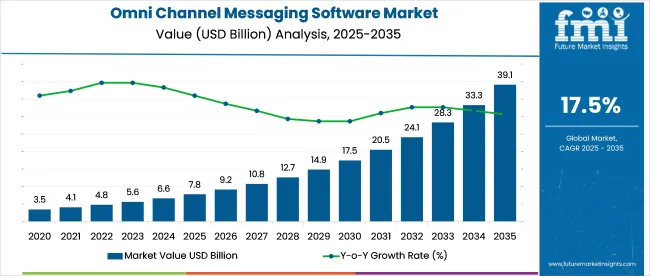
The omni channel messaging software market is undergoing accelerated growth, supported by the rising need for unified customer engagement and real-time communication across digital touchpoints. Businesses are prioritizing seamless, personalized messaging experiences to enhance customer retention, satisfaction, and lifetime value. Consumer expectations for instant, consistent responses across email, SMS, social media, and web chat have fueled enterprise investments in automation and platform integration.
Furthermore, digital transformation initiatives and cloud-native adoption have lowered entry barriers for businesses across sectors, enabling scaled deployment of messaging infrastructure. Emphasis on zero-friction interactions and data-driven marketing personalization has elevated the role of omni channel solutions within brand strategies.
The market outlook remains strong, particularly with increased penetration of mobile commerce and demand for always-on communication, positioning omni channel messaging software as an essential driver of enterprise CX innovation and customer loyalty.
The market is segmented by Solution, Deployment Type, and Industry and region. By Solution, the market is divided into E-Commerce, Order Management, and Others. In terms of Deployment Type, the market is classified into SaaS and On-Premise.
Based on Industry, the market is segmented into Retail FMCG, Apparel and Footwear, Consumer Electronics, Hospitality, and Others. Regionally, the market is classified into North America, Latin America, Western Europe, Eastern Europe, Balkan & Baltic Countries, Russia & Belarus, Central Asia, East Asia, South Asia & Pacific, and the Middle East & Africa.
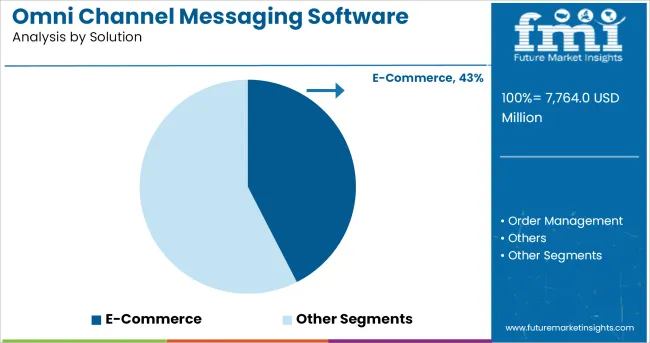
It is observed that the e-commerce sub-segment accounts for 42.50% of total revenue within the solution category, establishing its leadership in the market. This is primarily due to the growing reliance on omni channel communication to support rapid customer service, personalized promotions, and real-time updates throughout the buyer journey.
E-commerce platforms have increasingly adopted these solutions to unify engagement across social messaging, in-app chat, and email, which has led to improved conversion rates and lower cart abandonment. The sub-segment's dominance is further reinforced by the integration of AI-powered chatbots and automation tools that streamline post-sale communication and support scalability.
Enhanced shopper insights and customer behavior analytics have also supported its expansion, establishing the e-commerce solution segment as a cornerstone of digital retail operations.
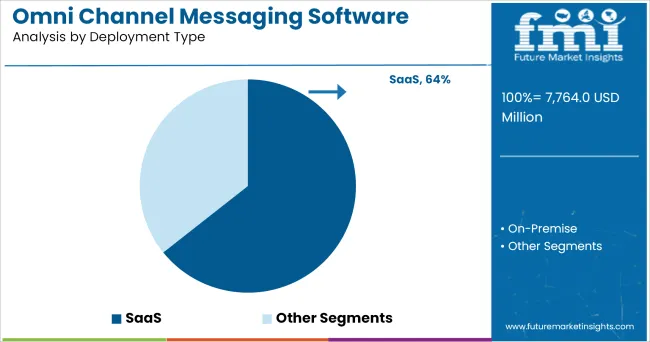
The SaaS deployment type holds 64.30% of overall market revenue, indicating its significant dominance within the deployment category. This leadership is attributed to the growing demand for scalable, cost-effective solutions that support continuous updates, multi-device accessibility, and rapid onboarding.
SaaS platforms have enabled businesses to avoid infrastructure overheads while benefiting from seamless integration with CRMs, marketing automation tools, and e-commerce platforms. The preference for subscription-based models and the flexibility to scale user access based on operational needs have supported this segment’s growth.
Additionally, enhanced security protocols, API compatibility, and centralized performance dashboards have improved organizational efficiency, leading to widespread adoption. This has positioned the SaaS model as the preferred choice for enterprises seeking agility and rapid digital communication enablement.
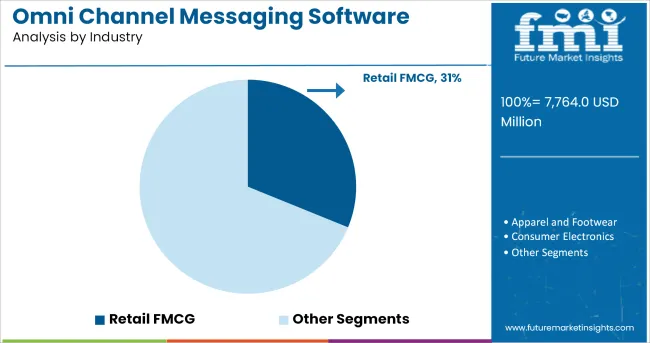
Retail FMCG has emerged as the leading industry vertical, commanding 31.20% of market revenue due to the growing need for dynamic, high-frequency consumer communication. The fast-moving nature of the segment demands consistent messaging across promotions, inventory alerts, and transactional updates.
Omni channel messaging software has enabled FMCG brands to deliver unified experiences through mobile, social, and offline channels, ensuring real-time engagement with both direct and indirect consumers. The rise of hyperlocal commerce, combined with the growth in digital loyalty programs and contactless fulfilment, has further increased demand for these solutions.
Additionally, integration with retail analytics and inventory systems has enhanced messaging personalization and reduced friction during purchase cycles. These factors have reinforced the segment’s position as a key driver of omni channel platform adoption within the overall market.
Adoption of smart phones and internet penetration has increased over the years due to which global sales via the online platform witness increasing growth. Also e-Commerce witnessing rise in adoption across both developing and developed countries across the globe fuels the growth of the omni channel messaging software market.
Omni channel messaging software provide better shopping experience to large retailers thus adoption of the omni channel messaging software among the
large retailers has increased. Due to easy availability of necessary resources and advanced technologies, medium sized and small retailers also starts investing in omni channel messaging software to sustain in the global market. Therefore increasing adoption of e-Commerce in the retail industry propels the demand for the omni channel messaging software market.
Increasing adoption of smart phones, tablets, and PCs in recent years fuels the growth of the omni channel messaging software market. Omni channel messaging software refers to communicating with buyers across multiple channels and able to receive and send case messages from multiple messaging platforms such as WhatsApp, SMS, and Facebook.
Increasing adoption of smart phones, tablets, and PCs ultimately fuels the online shopping of customers. Also omni channel messaging software provides better customer experience when client is shopping online from a laptop, mobile device, or in a brick-and-mortar store. Therefore increasing adoption of smart phones, tablets, and PCs augments the growth of the omni channel messaging software market.
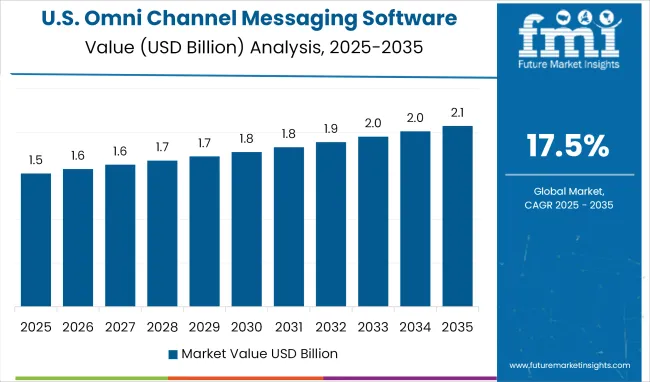
North America is anticipated to constitute a largest market share in the omni channel messaging software market over the forecasted period. The North America shows significant growth in omni channel messaging software market owing to adoption of advance technology Automated Machine Learning (ML) as data analytics and Artificial Intelligence (AI) in the North America region.
The large enterprises in North America region has adopted omni channel messaging software. Thus due to adoption of omni channel messaging software by large enterprises and SMEs in the region the growth of the omni channel messaging software has increased.
High presence of omni channel messaging software providers such as IBM Corporation, Salesforce.com, Inc., Cognizant Technology Solutions Corp., Oracle Corporation and many more. Presence of such key vendors in region fuels the growth of the omni channel messaging software in North America region.
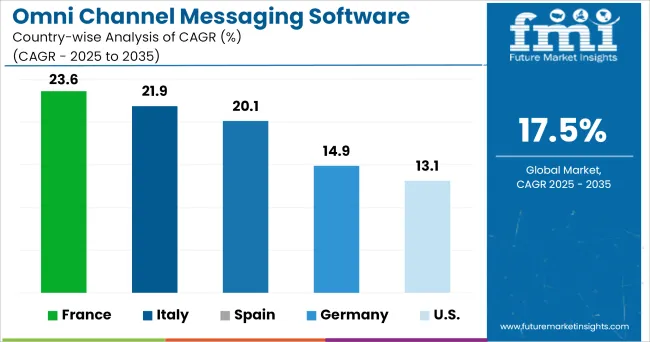
Europe is the second largest contributor to omni channel messaging software market after North America, owing to factors such as internet penetration, increasing adoption of smart phone, Tablets, & PCs and availability of new advanced technologies in the top European economies such as France, Germany, Italy, Spain and UK.
Europe witness advanced artificial intelligence customer service technologies such as speech analytics, web analytics, and text analytics. Also customer service technologies used by SMEs in consumer retail & good used to improve customer experience.
It helps to improve customer engagement and customer feedback by automating customer engagement. Therefore rising adoption of advance technologies such as ML as data analytics and AI in recent years spurs the demand for the omni channel messaging software in Europe region.
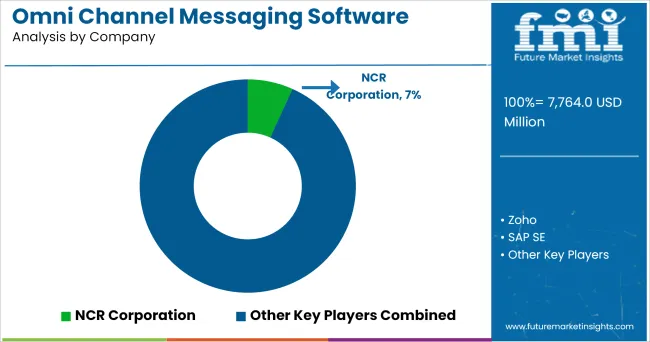
Some of the leading vendors and companies of omni channel messaging software market include
These key vendors have adopted various organic/inorganic strategies, to increase customer base at global market. They spends millions of dollars into product research and development to carry off the needs of their customers for omni channel messaging software market.
Furthermore, many companies are focusing on partnership, acquisition, and collaboration with other tach player to enhance their product offering.
For instance, In October 2024, SAP SE acquired Emarsys. Emarsys was omni channel customer engagement platform provider. This partnership helps company to create a new paradigm for how it will deliver hyper personalized, omni channel engagements in real time.
The report is a compilation of first-hand information, qualitative and quantitative assessment by industry analysts, inputs from industry experts and industry participants across the value chain. The report provides in-depth analysis of parent market trends, macro-economic indicators and governing factors along with market attractiveness as per segments. The report also maps the qualitative impact of various market factors on market segments and geographies.
The global omni channel messaging software market is estimated to be valued at USD 7.8 Billion in 2025.
The market size for the omni channel messaging software market is projected to reach USD 39.1 Billion by 2035.
The omni channel messaging software market is expected to grow at a 17.5% CAGR between 2025 and 2035.
The key product types in omni channel messaging software market are e-commerce, order management and others.
In terms of deployment type, saas segment to command 64.3% share in the omni channel messaging software market in 2025.






Full Research Suite comprises of:
Market outlook & trends analysis
Interviews & case studies
Strategic recommendations
Vendor profiles & capabilities analysis
5-year forecasts
8 regions and 60+ country-level data splits
Market segment data splits
12 months of continuous data updates
DELIVERED AS:
PDF EXCEL ONLINE
Parasomnia Treatment Market Size and Share Forecast Outlook 2025 to 2035
Hypersomnia Treatment Market Size and Share Forecast Outlook 2025 to 2035
Channel-In-A-Box (CiaB) Market Growth - Trends & Forecast 2025 to 2035
Multichannel Order Management Market Forecast and Outlook 2025 to 2035
Multichannel Reagent Reservoir Market Size and Share Forecast Outlook 2025 to 2035
Multichannel Networks Market Size and Share Forecast Outlook 2025 to 2035
Multichannel Infusion Pump Market
Multi-channel Remote ECG Monitors Market Trends - Growth & Forecast 2025 to 2035
Hotel Channel Management Market Analysis – Growth & Forecast 2024-2034
Single-channel Frequency Synthesizer Market Size and Share Forecast Outlook 2025 to 2035
NVMe Over Fiber Channel Market Size and Share Forecast Outlook 2025 to 2035
Electronic Multichannel Pipettes Market
Life Science Multichannel Campaign Management Market Size and Share Forecast Outlook 2025 to 2035
Demand of Protein Beverage Hybrids for Value Channels in Latin America Analysis - Size and Share Forecast Outlook 2025 to 2035
Software Defined Vehicle Market Size and Share Forecast Outlook 2025 to 2035
Software Defined Networking (SDN) And Network Function Virtualization (NFV) Market Size and Share Forecast Outlook 2025 to 2035
Software Defined Perimeter (SDP) Market Size and Share Forecast Outlook 2025 to 2035
Software-Defined Wide Area Network SD-WAN Market Size and Share Forecast Outlook 2025 to 2035
Software Defined Radio (SDR) Market Size and Share Forecast Outlook 2025 to 2035
Software License Management (SLM) Market Size and Share Forecast Outlook 2025 to 2035

Thank you!
You will receive an email from our Business Development Manager. Please be sure to check your SPAM/JUNK folder too.
Chat With
MaRIA